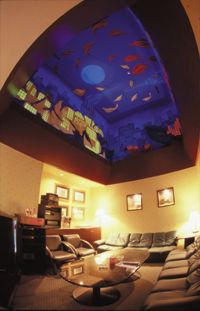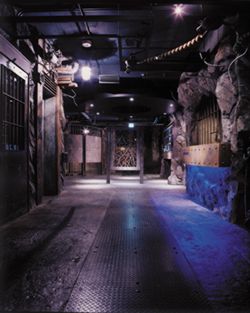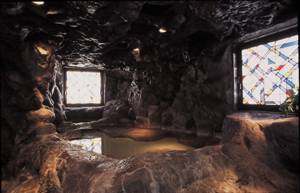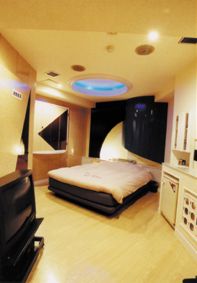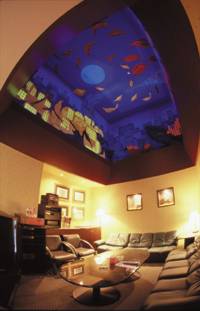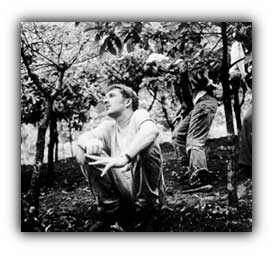japan on ¥425 a day - see the country in style
|
 |
| From Tokyo Journal August 1999 (part 1 of a 2-part story) |
| |
by David Duckett
|
I'm back. I return to Japan for a mission, one which will not only allow me to see the entire country, but I will be paid for it. I have no backers, no grants, not even a stipend from this magazine. I am a one-man team with the dream scheme the Mobile English Teacher. Rather than be bound to a school with regulations and the minions that enforce them, I will be a full-fledged freelancer, teaching those lonely souls tooling along Japan's expressways.
|
The idea bloomed from prior experiences and observations between 1991 and 1993. Two days after arriving in Japan I hitchhiked to Kyoto to explore employment opportunities. I waited a total of ten minutes, was fed twice, bestowed two packs of cigarettes, and handed ¥2000 for cab fare at the highway exit. My final driver apologized profusely for not dropping me at the door of my ryokan. The money meant nothing to him.
|
Yen then seemed of no consequence to Japanese. Street sellers financed their Asian travels by hawking cheap prints and motorized pandas for exorbitant fees. For the September 1991 Tokyo Journal cover story I had discarded 10 wallets - each with ¥1000 and half were immediately sent back with cash intact. As an eigo no sensei I was persistently given presentos, meals, and nights on the town, all for the same reason Mallory climbed Everest. Because I was there.
|
Every prosperous business in Japan has four basic requirements: an office, a business card, advertising and a manga logo. I employ the skills of Bill, a former roommate and current media designer. We brainstorm at his home in Myokokogen, Niigata-ken in late May and create a state-of-the-art, bilingual, laminated sign. One side states, "Mobile English Teacher," and the other informs, "Your Car is My School." Advertising and office space are quite simple. The manga logo is carefully constructed as the proper maniacal caricature is key element for success here. My face hurts after a grueling modeling session.
|
The business card is a more complex matter. Actually, it's more of a payment card which explains my revolutionary career move. It informs prospective clients that I'm a professional English teacher from Tokyo and decided to go freelance, taking my talent to all prefectures. It delicately states that I'm not really going anywhere in particular and expect to be paid whatever the client thinks the lesson is worth. We also process 150 stickers of my manga logo, for students also deserve a physical reminder of their well-spent yen on an otherwise meaningless trip along the expressway.
|
Surely, all this preparation will result in huge financial rewards. If Japanese drivers are willing to feed me and pay for my taxi when I'm merely hitchhiking, imagine the reimbursement for providing a professional service. I depart the spa resort of Myokokogen with audacious confidence.
|
It takes three minutes to attract my first customers. Kenji and Tanaka are heading up Route 18 for a barbecue on the Sea of Japan. The 21-year-olds carefully read the payment card, chuckle, and invite me into their car/my office. I diligently scribe the mobile lesson's nuances on my mobile whiteboard (a memo pad with detachable pages) and they thoroughly enjoy the lesson.
|
The lesson ends at the Hokuriku Expressway interchange in Joetsu where I hand them the notes from the mobile whiteboard along with my personal manga sticker. Hoping for an ichi-man note, I am instead presented a can of coffee and two bulbous onigiri balls. I'm invited to the beach barbecue but decline the offer. This would be like calling in sick the first day at a new job and I need to procure a nest egg before going on sporadic jaunts with clients.
|
A man with severe physical deformities approaches me on foot in front of the expressway tollbooths. His forehead is the size of your average circus giant while his chin and jawbone would fit perfectly on a Girl Scout's skull."What are you doing?" he asks in manageable English. "I'm a Mobile English Teacher," I proclaim, flipping my sign around. We plow through the usual question-and-answer survey popularized by every English program in Asia. I correct Yamahashi's mistakes and amend his pronunciation.
|
Yamahashi is also working this Sunday. He supplies box lunches to tour buses and waits for them here. The bus he awaits is late so he places a call on his mobile phone. After a stream of cars pass I turn back towards Yamahashi and a ¥1000 note replaces the phone in his mangled right hand. My first payment! I'm not even in his car. Hell, the parking area is my school. Anything's my damn school as long as I talk to you.
|
My next two students, a salaryman and young unemployed man, drive me southwest along the Sea of Japan. I have never seen it and barely get a glimpse as the expressway is more tunnels than open road. Like my first customers, both men peruse the payment card but fail to grant me any yen. I wonder if I should hand my students an empty envelope with the payment card. I am, however, awarded a meal, two coffees and a pack of Caster.
|
I had set off in late afternoon, so I resolve to call it a day at a rest area near Toyama. I string up my Mexican hammock under an octagonal roof and use the wooden benches to store my provisions. Twilight fades to darkness as I fret over such an unproductive debut. I am, however, bolstered by Yamahashi's lesson. Plus, my belly is full, I'm ¥1000 richer, and my clothes aren't even that dirty. I extinguish a Caster, roll on to my side, and slumber off as drizzle splatters on the roof above me.
|
My view of the world is obscured by close-knit webbing on my face. I slowly realize I am in Japan, the sun is high, and I have overslept like a drugged koala. I presumed I would have woken at the crack of dawn and pocketed a cool ¥5000 by mid-day. But I find myself shaving at noon, cursing the checkerboard-patterned apparition in the restroom mirror.
|
While shaving, storm clouds gather, foreshadowing a horrific day. Soichi, a salaryman in a white sedan, receives an ace lesson on his way to Kanazawa. The hour is worth a ¥500 piece, coffee, and the remainder of his Seven Stars. Drizzle transforms to a downpour the moment I'm dropped off at the Tonami rest area.
|
After two hours the rain subsides so I take my spot at the highway entrance. Instantly, two highway maintenance men accost me and explain that I can't be on the highway. I tell them how well I know that, and I am indeed on the entrance ramp. Regardless, they call the local authorities and buy me a can of coffee. As we wait for the flatfoots, a Japanese hitchhiker emerges from the highway. "There's your man!" I say, pointing at the fugitive. Embarrassed by their obvious mistake, the maintenance men offer another coffee but I change the order to ice cream. It really hit the spot.
|
The Toyama police show up after an hour. They apologize for their tardiness and make amends by scoring me a can of coffee. I'll drink an entire Colombian mountain range before this trip is over. The cops and maintenance boys converse and it's obvious the Japanese hitchhiker was the one on the highway. I'm free to go but it's teeming again.
|
As I wait out the storm in the restaurant, a gregarious 65-year-old truck driver offers a lift to Kyoto. I accept Tanabe's offer without employing the payment card. My first full day of work is a wash, figuratively and literally. However, he could be my greatest payday of all time. Other than supplying me with coffee, cigarettes, and a meal, he promises half of his earnings from the lottery tickets he buys.
|
Rather than string up the hammock at midnight, I crash on the welcome mat in front of a second floor restaurant in a rest area north of Kyoto. It's warm, dry, and the cafe opens the following morning at 7:00 am. I'm assured an early rise.
|
The panorama of Lake Biwa from the Otsu rest area is somewhat ethereal at dawn. Puffy storm clouds separate allowing vivid rays to dance among the shores and surrounding hills. There is nothing manmade within my sights but there's an odor, a foul odor, a familiar funk. It's me.
|
I bathe in the rest area bathroom and from the waist up I'm immaculate. It's 5:30 am, the clouds have dispersed, and I resolve to get this gig underway correctly. A full day of fine weather ahead, I'll knock em' dead and collect my warranted fees.
|
My first three rides take me past Osaka, through Kobe, and over several bridges to Shikoku. My students, a bakery deliveryman, a surfer and a single woman named Yuki, have two things in common; they failed to dish out yen but feed me meals with the customary coffees. Bloated and now immune to caffeine, I fall asleep in Yuki's red compact. She wakes me at her destination of Naruto, the eastern point of Shikoku, and we're no longer on the expressway.
|
Stumbling around trying to discern just where I'm headed, a white Subaru strewn with stuffed animals pulls aside. The young woman behind the wheel looks great, seems excited by my presence, and I don't care where she's headed. By asking for her name (Saori) at the tollbooth I have officially taught English in Shikoku. We drive back to Honshu.
|
Again I crash-out during the lesson, the BIG taboo in English teaching. Saori wakes me delicately at a rest area west of Kobe and invites me to her home to listen to a Jewel album. I'm not sure why I declined (temporary insanity?) but my day's wages are merely cigarettes, six coffees, and enough food to satiate Akebono.
|
I'm rationalizing my poor start on bad weather, too much food, and a sudden propensity for sleeping when a white van pulls over. It's occupied by three house painters who are the least bit interested in English. I accept the ride merely to get out of an afternoon drizzle. I don't even bother with the payment card, as this troika is keen for post-work beers and to laugh at the strange Gaijin in their van. As I crawl out of the van the boys shock me by lifting their wallets. Each slips me ¥1000.
|
From agony to ecstasy, back to agony, I enter Taizi's four-door red sedan. The maroon-tinted windows match his hair. He glances at the payment card and immediately shucks the expressway to pick up two mates who resemble KISS groupies. Close to You by The Carpenters emits from a compilation tape and the trio knows all the words. The car has no shock absorbers and, like most Japanese drivers, Taizi uses a pungent air freshener and never opens the windows. A splitting headache ensues as we bounce around the southern rim of Honshu on Route 2. After two hours we miraculously discover an expressway entrance in Ako. Again, my rewards are cigarettes and coffee.
|
All I want now is a rest area, paycheck or not. Hiro, a well-groomed university student, rekindles my spirits with a lift to the opulent Okayama rest area and ¥1000 payment. I sling my hammock adjacent to a well-groomed rock garden and review my roller-coaster day.
|
I'm earning a pittance and I ponder whether I should be more demonstrative of my aims before accepting a ride. However, my largest bounty came from those who were never shown the payment card. I'm confused. I'm gaining weight, losing face and certainly not losing any sleep over my quandaries.
|
I curse myself for being let off at the Hiroshima interchange. During morning rush hour it's a swirling mess of congested ramps with very little room for a car to pull over safely. Yoshi, a dapper salesman in a black Honda, was a fine student, beginning my day with a lift to Hiroshima along with a ¥1000 payment. He, however, has a problem with listening comprehension, ignoring my requests to be dropped off at a rest area.
|
A 44-year-old housewife in a Mercedes rescues me. I don't flash the payment card as I truly need to leave this horrible spot. Kyoko is a wonderful English speaker who adores anything with an international flavor, including me.
|
Meeting me is her highlight of the decade, which of course means I can't refuse to spend the entire day with her on nearby Miyajima Island, where she spends ¥20,000 as my five-star tour guide. The bonus of the day is all natural juices I order with meals. I avoid coffee.
|
Kyoko is in tears as we depart at the Miyajima rest area at 5:00 pm. She utterly dropped whatever else she was planning to do today. Moved by her blind kindness, I'm numb standing at the entrance ramp at dusk. Those who never eyed the payment card have been the most generous. I conclude never to employ it again, and rather than shoot for the mother lode, I'll enjoy myself.
|
A semi-truck is the first vehicle to approach and the squeaky sound of its air brakes signals the quickest of rides. Shigeru is pulling an all-nighter to Kagoshima and offers his in-cab bed to me. I sleep for ninety percent of the 700 kilometer journey. The other ten percent Shigeru lavishly apologizes for not speaking English.
|
I'm jostled at dawn in southern Kyushu. Shigeru is offering breakfast in bed a smidgen north of Kagoshima. It's obvious we had parked hours ago by the makeshift bed across the front seats. While departing at the Kagoshima Ferry Terminal, Shigeru hands me four hand-painted postcards, landscape watercolors he had carefully brushed. My guilt is as thick as the grime covering my flesh.
|
Seems I'm not the only cretin bathing in public restrooms across Japan. The ferry terminal's bathroom is very competitive around the hot water taps and it's no surprise the homeless call this ostentatious depot home. I had never noticed street people in Japan during the early 90's. Perhaps the wilted economy is the demise of my fortune.
|
I can't hitch the ferry to Sakurajima so I fork out ¥120 for my first transportation fee. Sakurajima is a stunning live volcano where I spend the morning checking out the sites. In the lava fields a New Zealand tourist asks me where I'm staying. "I think I'll stay at Cape Sata tonight," I tell him vaguely. "I didn't know there was a hotel down there. Did you make a reservation?" "I have no idea if there's a hotel," I explain. "I'll find some shelter and sleep in my hammock." The Kiwi actually backed up as I spoke. I'm sure he thought I was a criminal on the run.
|
I hitch the coast road down to the Cape Sata, the southernmost point in mainland Japan. The mountainous and densely-wooded landscape is stunning. Sata town is so quiet I can hear my cigarette burn. I walk into a store to purchase some dry goods for a possible camping foray but there is no clerk. I say, then eventually scream, "Sumimasen!" No one appears. I could have cleaned-out the joint, but then the Kiwi would have been right.
|
After four short rides I arrive at Cape Sata with a liter of water, three bags of mixed peanuts, and several packs of cigarettes, none of which I purchased. Although my original motive of amassing wads of yen is failing, reaching an extremity exudes a certain euphoria. I revel in it.
|
After an hour of misty solitude, rain convinces me to begin my return voyage. The thin roads and small towns of the area produce several bizarre rides as I make my way to Miyazaki on the east coast. The Kitamura family - dad, mom, and one year-old - provide the most surreal trip. We immediately get lost. An hour of winding roads, air freshener and extreme guilt have me nauseous. Suddenly, a mammoth lighthouse appears and we have reached Cape Toi! It's pretty much in the opposite direction of Miyazaki. Mr. Kitamura is the world's friendliest person with the worst sense of direction.
|
I take control of the navigational duties and steer us to the closest crossroad that leads them home. I apologize to mom but she appears confused, as if they do this all the time and it's a barrel of monkeys. The baby never cries and apparently relishes the trip. Dad tops it off by leaving me with a bag stocked with pastries, a canned coffee, and two packs of Mild Seven.
|
I set up my hammock on a small peninsular in Nango, a picturesque fishing village in Kaigan Coastal National Park south of Miyazaki. The moon almost full, I break into the chocolate chip breadsticks for a nightcap. Another day, not another dollar. Striking infant islands protruding from the sea are the first effects to bless my eyes this morning. Pity the sleeping sento manager who has me as his first sight at 5:00 am. Completely clean and refreshed I reach the Miyazaki Expressway by 7:00 am.
|
About 80 percent of all cars in Kyushu are white. At one rest area, 33 of 34 cars were bleached. No one seems to know why but they contrast the greenery brilliantly. Aesthetically, Kyushu is my favorite area in Japan. To describe its beauty is simple. It's exactly not like Tokyo.
|
Four white automobiles keep me dry while their owners feed me through Kyushu. I receive no cash today but Jun, an off-duty cop, hands me an expensive fishing lure for his lesson. The fifth white car delivers me from Fukuoka to Hiroshima. It's driven by Jen, a 46-year-old district supervisor for some enigmatic semiconductor company.
|
"Where are you staying?" Jen asks as we entered Hiroshima. "With a friend who teaches English here," I lie. I don't know anyone here. I truly want to sleep in Peace Park, my hammock knotted on zero-ground. But one white lie just leads to others. "Okay, where does he live. I can take you there." "I think he's working until nine. He lives near Peace Park. You can drop me off there. You've already gone to enough trouble." "Perhaps we can eat first and you can call him on my mobile phone." "Okay," I utter, forced to continue the charade. We swill beers and premium saki at his favorite ramen shop. He makes me eat cow's tail, cow's tongue, and other nasty things. I'm slightly drunk at the bewitching hour of nine. "You should call your friend now. What's his name?" "Daniel," I say instinctively. Daniel is a former roommate who lives in Tokyo now and carries a mobile phone. I call him. "Daniel! David here. I'm in Hiroshima a little early. Are you finished work yet?" "What are you up to man!?" Daniel says with a conspiratorial tone. Jen can only hear my side of the conversation. "You're where . . . Shikoku? You're not here! I thought you had to work on Fridays." I say with a feigned look of shock. "I don't know what you're doing but I'm with an Irish chick here. Wanna talk to her?" "Oh, really. So you're not coming back here tonight?" It didn't matter what Daniel or the Irish chick had to say. I talked myself homeless in front of Jen. Jen listens intently and figures that Daniel was in Shikoku and his Hiroshima apartment was locked. "Where will you sleep?" Jen asks after I hang up. "Anywhere! Perhaps Peace Park." Jen and the noodle shop owner just laugh in my face, pour me more beer, and tease me about the dangers of bike gangs. Eventually, Jen invites me to his home.
|
Wealthy and lonely, I immediately feel like his rent-a-buddy. I rise the next day at noon with a nasty hangover and am immediately introduced to Mark, a virtual clone of Jen. For breakfast, it's more unknown disgusting food and beer, which is just a primer for a day of agony, visiting every site in Hiroshima except the one I wanted to see Peace Park and its museum. Jen doesn't like the concept.
|
"We should forget about the atom bomb. Peace Park is bad."
|
After 24 hours with Jen I manage to escape, my price is being dropped off at the dreaded Hiroshima interchange under a full moon. I pray for a drunken supermodel with a gold card. I'll take an obachan with an eye patch, anything but another middle-aged man in a white sedan. After 90 minutes I'll take a serial killer.
|
Finally, a lawyer in a white sedan stops. He's going to Osaka but I depart at the rest area in Okayama. I need sleep. Jen and the Hiroshima interchange have sapped all my energy.
|
I wake up chilled as my hammock is soaked with dew at 3:00 am. As confused as I am about my mission, two short-term goals become clear; shave and get my ragged ass to Daniel's apartment in Tokyo.
|
Towards sunset in Nagoya, a short man with a dog approaches me on foot. His bastard seems to enjoy sniffing my backpack.
|
"You are an English teacher?" the short, fat man blurts.
|
"Yes." I keep my answer simple.
|
"What are you doing?" the short, fat, nosey man asks with an accusing tone. The dog snarls when I try to pet him.
|
"I'm teaching all over Japan. Will your dog bite me?"
|
"Maybe. You can't hitchhike in Japan. No one will pick you up. Where are you from? What will you do if no one gives you a ride? Where do you sleep?"
|
"Could you get your dog away from my bag?" I politely ask the short, fat, nosey-ass bastard. "I think he's going to piss on it."
|
"No," he replies and reiterates his previous questions. I simply want to tell him to fuck off but he's got a beast with an attitude. I respond politely but he persists.
|
"No one will pick you up. You can't hitchhike in Japan. Where will you sleep tonight? The police will arrest you." The dog urinates about 10 centimeters from my bag.
|
|
"Actually, the police have bought me coffee and ice cream. It's perfectly legal."
"But no one will pick you up."
|
"Not with you and your dog here." I finally snap. "Look, someone will pick me up. I was in Okayama this morning. It was nice meeting you." I could hear both of them growl as they returned to his car. He shook his finger "no" as he drove past me.
|
My final ride is courtesy of a yakuza thug whose mumbling prevents me from getting his name. I ask if he has any children. I can't understand so he flashes two and a quarter fingers. He obviously had made some boo-boos on the job but still manages to support three children. Drunk, his driving is atrocious in the usual Sunday evening traffic on the Chuo expressway. We almost crash twice and he mouths-off to several motorists during stoppages. Kawasaki train station never looked so inviting.
|
I rail to Daniel's apartment, I count my funds and discover I have cleared ¥96 after eight days' work. I wonder how long it will last on my way to Cape Soya, Japan's northernmost point.
|
Will David reach Cape Soya to be return with a bag of beans? Will David return a rich man? Find out about it in the September TJ.
|





